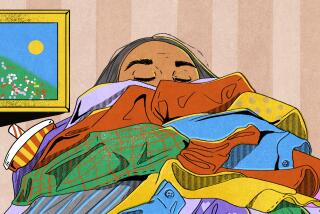Do You Really Need That I (Heart) N.Y. Cup?
- Share via
Stress is a major factor in many of our health-related problems. A key way to reduce stress is to simplify. By reducing clutter, commitments, tasks and expenses, your life will streamline into the Stress Free Zone. Elaine St. James tells us how.
*
Recently, a magazine editor asked me, “How many cups do you have in your cupboard?” “Four,” I said, “plus two I just received as gifts.”
She went on to tell me that the first thing she had done in her effort to simplify was to take all of her cups down and put them on the counter. She was surprised to see that she had 36 cups for her family of four. At least half of them were souvenirs from places the family had traveled, and included a variety of “Best Mom” and cartoon cups the kids had given her over the years. She also had a collection of cups her mother had saved and that were now taking up space in her cupboard.
“I asked myself, How many cups do I really need?” she told me, “and I realized that we rarely have more than the four of us in the house at one time. Why did I need 36 cups? My big triumph was cutting back to eight.” However, she added, the hardest thing was to get rid of her mother’s old cups. She voiced the concern that I’ve heard hundreds of times: Our mothers went to so much trouble to save these things. Who are we to throw them out?
It helps to keep things in perspective--to appreciate how many things have changed since our mothers’ day. Our mothers had more space because they didn’t have all the so-called convenience equipment--the Cuisinart, the bread maker, the pasta maker, the cappuccino maker--taking up the space they did have. So they had room to save multiple sets of dishes and glassware, as well as baby books, baby shoes, old record albums, toys, and all their kids’ artwork and memorabilia, and they had more time than we do to take care of all of it.
According to a recent Time magazine story, our kitchens are getting bigger and bigger, and more filled with gadgets we never use because close to half of the money Americans spend on food is spent on food prepared outside the home. We’ve got bigger and better kitchens, but no time to cook and no time to take care of the stuff, which often just keeps piling up.
Also, keep in mind that many of our parents grew up with the Depression-era mentality that said you never throw anything away if you might be able to use it someday. Unfortunately, this often got translated into “never throw anything away, period.” When my dad died, he had 30 nearly empty cans of paint stacked in his garage, most of which dated back many years. “You never know when you’ll need to do a touch-up,” he always said.
People often ask me how they can get their parents to get rid of the stuff they don’t need or even use. The answer, for most of us, is that we can’t change our parents. But we can change ourselves, even if we change just a little bit at a time--like the woman who eliminated 28 cups. Once she realized how liberating it was to be rid of the cups, she started on the extra dishes, and then began eliminating the small appliances and cookware she never used anymore.
People often tell me they didn’t realize what a burden some of their possessions had become until they gave them away. Afterward, they couldn’t believe how much freer they felt, and their only regret was that they hadn’t done it sooner.
*
Elaine St. James is the author of “Simplify Your Life” and “Simplify Your Life With Kids.” For questions or comments, write to her in care of Universal Press Syndicate, 4520 Main St., Kansas City, MO 64111, or e-mail her at estjames@silcom.com.


